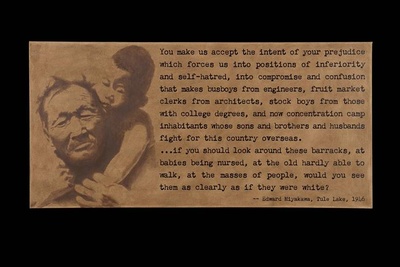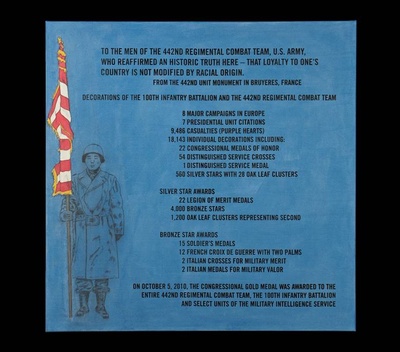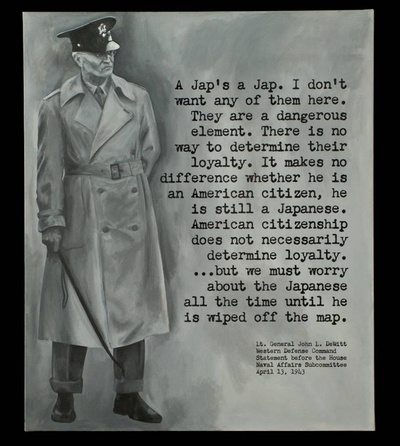Seven years ago, I moved back to Portland to be with my family. During this time, I was compelled to pursue painting on a large scale. As a Sansei (third generation Japanese), I became fascinated with my parents’ experiences during the events surrounding WWII and the incarceration of Japanese Americans. It is my own emotion that compels me to convey this material on behalf of the larger Japanese American community, and for my own family, legal American residents and loyal citizens who suffered at the hands of their own government.
When I was growing up in Portland, my mother spoke rarely of the hardships her family had experienced as West Coast Issei and Nisei—first and second generation Japanese Americans—during the years of World War II. My parents discussed their experiences with their camp friends, but the shame was too great for them to share it with their own children.

A single quote sent me on a two-year journey of researching books and oral histories to give voice to Japanese Americans who were forcibly interned in camps from 1942-46, like my mother’s family; or, like my father’s family, who moved to Eastern Oregon to work as impoverished farm laborers under repressive conditions.
The result of my research is a series of canvases with quotes from Japanese Americans who experienced discrimination and hardship during the war. I chose words that embody the strong emotions my forebears felt but rarely expressed. I’m concerned that the Nisei are now in their 80s and 90s, and their words may be lost as they pass on.
The journey to create the canvases also led me to notable Japanese Americans such as Oregon’s Poet Laureate Lawson Inada and Hawaii Senator and WWII hero Daniel Inouye. Both granted permission for me to use their words in my work. There are 12 canvases in the series.
This series also acknowledges the 442nd Regimental Combat Team and the 100th Infantry Battalion, the most heavily decorated battalion in U.S. history. These Japanese American soldiers suffered nearly 9,500 casualties while fighting loyally for America.

Quotes from Japanese Americans are juxtaposed with official government statements and propaganda on the perceived threat of Japanese Americans to U.S. security. These quotes particularly moved me. They provided true insight into the wartime experience of the people I knew as hard working, kind, and gentle. They were so proud to be Americans. In return, they were viewed with suspicion, and stripped of their businesses, land, financial assets, and homes. Many began their lives after the incarceration with nothing but a few personal possessions. My family members were only able to find work as domestic help, crop pickers and gardeners.

In 1988, the United States government finally approved financial redress to all living Japanese Americans. The payment of $20,000 amounted to very little compared to what most lost in terms of land and earthly possessions, once inflation was factored in. In addition, many of the first generation had passed away by the time the payments were issued. My own grandfather passed away in 1982, at age 95, before the redress.
It is the words of writer Michi Nishiura-Weglyn, author of Years of Infamy, that are the real lesson for all of us. Nishiura-Weglyn’s book is largely credited with the movement to compensate Japanese Americans for their losses: “...this uniquely American story will serve as a reminder to all those who cherish their liberties, of the very fragility of their rights against the exploding passions of their more numerous fellow citizens, and as a warning that they who say it can never happen again are probably wrong.”
The ten large painted and silkscreened canvases will be on display at the Washington County Museum in Portland, Oregon through October 29, 2011.
* * *
The Day We Left
June 27 through October 29, 2011
Washington County Museum
17677 N.W. Springville Road, Portland 97229
© 2011 Sharon Inahara



